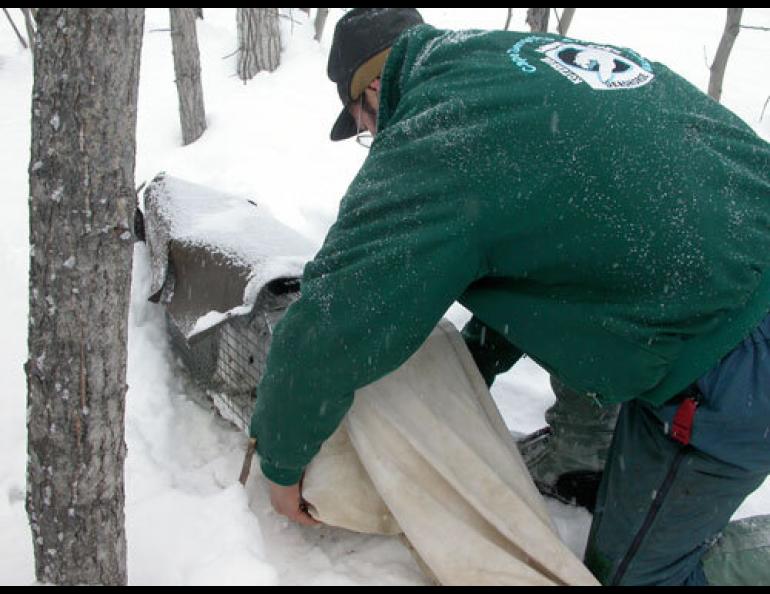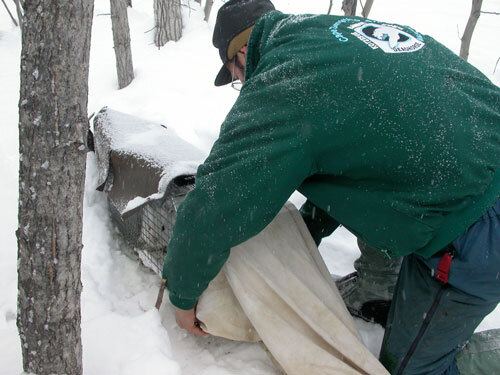
The brief life and times of snowshoe hares
Here on this March morning, in the forested floodplain of the Tanana River, snow is falling with vigor. Even the paddle-feet of snowshoe hares press several inches into the new fluff.
Knut Kielland wears metal-frame snowshoes as he zigzags through alders and willows near the frozen river. He stops when he sees a snowshoe hare, right where he expects it—inside a wire-screen metal box.
The hare, which ventured into the live trap in pursuit of alfalfa chunks and a carrot, wears a collar with a tiny transmitter the size of a triple-A battery. Kielland, an ecologist at the University of Alaska Fairbanks, and his colleague Karl Olson have captured this animal before.
Kielland coaxes the hare into a game bag, then weighs the three-pound, snow-white creature, checks numbers on its ear tags, and releases it into the forest. The hare then bounces away, seeming to disappear into the winter world. But Kielland can find it anytime he wants, using a binocular-size radio receiver and a handheld antenna that resembles a TV antenna.
Kielland and Olson have fitted 50 transmitters onto the necks of hares and often recover them again and again. Once a transmitter was recovered from high in a spruce tree where a goshawk carried its meal. Using a receiver and all of those transmitters, Kielland is trying to find out the fate of the average hare. He wants to answer a simple but elusive question: how long does a boreal forest hare live in Alaska, and how does a population of hares fluctuate?
“(With methods such as ear tags), you don’t know whether the hares dispersed out of your area or died,” he said. “This is an attempt to really find out what happens to them.”
Biologists think hares probably live for about a year, with old-timers reaching three or four, but there are few ways to judge that. Kielland’s study, which is the extension of a project he’s been working on in his backyard of the Tanana River for a decade, should provide some answers.
The transmitters now carried by about 30 hares in the Bonanza Creek Experimental Forest emit a steady beep when hares are on the move. When one stops moving for about six hours, which means it’s probably dead, the beep rate doubles. Then, Kielland and Olson turn on the receiver, unfold the antenna, and go on a search for the collar. Not long ago, they found that a lynx they had been tracking with a satellite collar had intersected the path of a hare, the collar of which then started beeping rapidly.
“Our collared lynx ate our collared hare,” Kielland said.
Why study hares? The little creatures with the boom-and-bust cycles (which are currently near a peak in the Tanana valley) are food for just about every predator out there, from owls to lynx to coyotes to red squirrels, which hit the hares surprisingly hard just after young (leverets) are born, researchers in the Yukon found.
Hares produce lots of offspring, dropping litters of as many as five leverets up to three times each summer. That’s a potential 15 little hares from one female, but hares disappear fast under pressure from predators and from starvation. Seven out of ten hares collared in June 2008 are no longer alive.
“They do bite the bullet in winter,” Kielland said.
In a patch of the Interior he has studied, trapped, and hunted in for many years, Kielland monitors the hares each year for intense four-day periods in June, August, November, and March to learn more about one of the most important little creatures out there, a substantial meal for carnivores in the hungry country of the boreal forest.
***
The granddaughter of Alva Wisdom, a Seward man killed by a tsunami resulting from the 1964 earthquake, wants to know if anyone out there remembers Alva and his wife Mabel. If you do, send me an e-mail.





